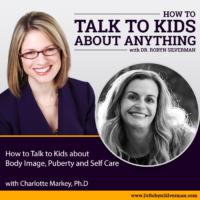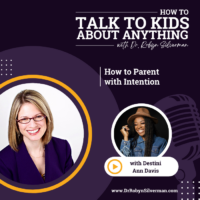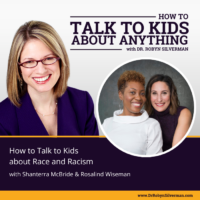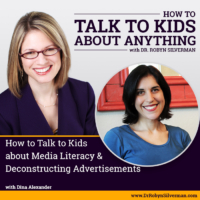Podcast: Play in new window | Download
Subscribe: Apple Podcasts | RSS | More
How to Talk to Kids about Adoption, Foster Care and Attachment
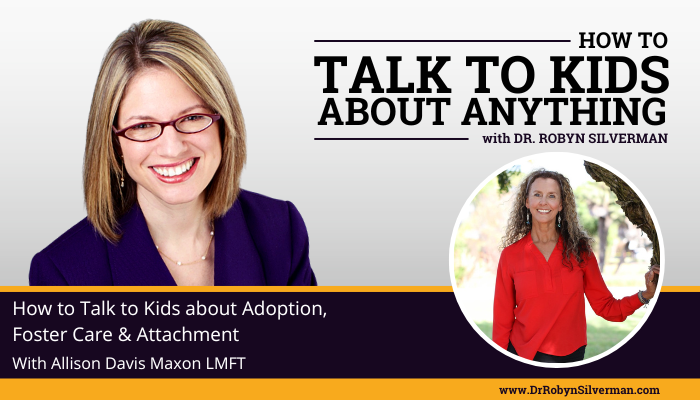
This podcast will talk about how many people have the wrong idea about adoption and kids. Adoption is nuanced and those involved in adoption are human! Experts in adoption have found that children, adoptive parents and birth parents may grapple with seven different core issues in adoption and permanency. Let’s discuss them today and find out how to talk about them with our children and teens.
Guest Expert: Allison Davis Maxon, LMFT
Many of you who have followed the podcast for a long time—and thank you, we are just about at 2 million downloads now, you know that my husband and I adopted 2 children 12 and 13 years ago through an open adoption with people we love. When people think of adoption, especially when they don’t have first hand experience with it, may have some preconceived notions about how the people feel and who they people are who are part of the adoption experience—the birth parents, the children and the adoptive parents. Some might believe that the birth parents are deviant in some way—or callous—or uncaring—that the adoptive parents are saviors and do-gooders and the children are simply grateful and lucky. But there is a lot to adoption and talking about adoption with kids—because the people who are involved are human and multi-faceted, good and faulty, loving and trying to do their best in a situation that has more to it than meets the eye. I am grateful for my children and to their birth parents—and I also know that there are more emotions that go with adoption than gratitude. How do we talk to kids about adoption and the issues that may be part of their adoption experience—or the adoption experience of those we know and love? For that, we talk to Allison Davis Maxon.
Allison Davis Maxon is an expert in the fields of child welfare and children’s mental health specializing in attachment, developmental trauma, and permanency/adoption. She is the executive director for the National Center on Adoption and Permanency and was the child welfare consultant on the Paramount Pictures movie “Instant Family.” Allison was honored in 2017 with the Congressional Coalition on Adoption Institute “Angels in Adoption” award and is the co-author of Seven Core Issues in Adoption and Permanency.
Important Messages:
- For some, adoption comes with issues of neglect and trauma because of what they’ve been through in the past.
- Instant Family: A snapshot of Allison’s life!
- There are profound losses—this is one of the main core issues.
- History of adoption: Secrecy and Shame. People kept it from their children.
- There are losses- intergenerational losses.
- These losses can lead to the second core issue: Rejection. Abandonment. There is grief for many.
- Lack of genetic mirroring. Issues can intensify during teen years when identity comes into play so much more.
- Grief is a gateway to healing—acknowledge the loss.
- There are constellation members– they’re not the only ones with losses. You have grandparents that lost a grandchild. You have aunts and uncles that lost a niece or nephew. The ripple effect on the birth first familial tree of that loss. And the reason for that loss, our history in this country that came from the original. It was originally it was domestic adoptions. Now the majority of adoptions are from foster care. It’s why you hear my shift in language birth first family birth, first parents. Because many of the children that are adopted today from foster care were parented by their first parents sometimes for years.
- Emotional landmines
- You must address your grief. Any blockages I have in my own grief or stuckness or triggers that I have will come and be played out through my parent-child attachment relationship.
- If I adopted my child at birth and now they’re five years old and they’re really starting to understand, wait, I didn’t grow inside of you. No, you grew inside your birth first mommy and she gave birth to you. And, and by the way, we don’t really understand that developmentally until we’re five, six or seven.
- Have to acknowledge when it’s hard for kids. Sometimes being adopted is really hard. Let’s talk about being adopted right now because I can tell that’s hard for you in this moment. So instead of us act or reacting as a parent might like defending themselves, like, how dare you, I am your real mom. Like, we can, we can go into a defensive posture when, when my child is bringing that up, they’re in the middle saying, it’s hard to think about somebody else in this role then I don’t maybe even know that person. Because lots of times there isn’t openness in adoption. Imagine feeling like you’re a child, trying to understand, wait, I, I grew inside someone else.
- Allison tells this story: It takes a man and a woman to make a a baby. Always. That baby grows inside the woman’s body, inside a place called her womb. She gives birth to that baby. If that baby D isn’t raised by those two parents and is raised over here in this forever family, that’s called adoption. And I usually show this in a visual way cuz as you know, kids are very visual, auditory processing isn’t their strength. So I’m using right stuffed animals or I’m using a visual picture.
- So I tell this global story to this young man. He’s almost nine years old. He starts, he, he starts sobbing and shaking on my floor, sobbing and shaking on my floor. And I, and in the moment I just was rubbing his back, I didn’t quite know what had happened. So I just was comforting him. He was sobbing, uncontrollable, you know, when the body goes into this uncontrollable full body saw, when he finally calmed down, it took a few minutes and I just said, you know what happened? Tell me what happened. And he said, I thought I grew in a tube.
- What makes adoption so hard for parents, is the child’s story begins with loss and trauma. So often adoptive parents are trying to protect children from the loss and the trauma so they make up a nice story that often begins with their story.
- Begin with the child’s story—not your story. Your story is your story—that’s not the child’s story.
- There’s diversity in the adoption experience.
- Each kid has a suitcase packed with all the core issues and you want them to unpack it, not try to fix it for all the grownups.
- They often don’t want their parents to be upset with them.
- Scary for adoptive parents because they don’t want to be rejected.
- Open adoption is healthiest for a child (as long as it’s safe).
- The birth parent story is often told through the adoptive parent lens, not the person that the story begins with. It’s so helpful to a child and the adoptive parents to, to be relationship builders.
Diverse family structures: We have stepparents, we have foster parents, kinship parents, a lot of grandfamilies right now. Like we’re very, we’re we’re used to a lot of diversity inside fam family systems. - Legal parents and there are genetic parents and there are attachment parents. In adoption, the legal parents become the attachment parents.
- And we really do want adoptive parents to acknowledge that their own core issues are connected to that.
- Genetic mirroring is really validating for the child that when I can get, and I work, I do a lot of openness and search and reunion when I can get all the grownups really working well together, that’s best for the child because the child can go, oh, my parents aren’t in conflict with one another.
- Activity: Two mason jars and with your kid you’re going to cut out all these slips of paper and one of the jars is going to be their lost jar. So you label on the jar loss and we want kids to be able to, over time and sometimes with a grownups help. Whenever you’re feeling some of that, some of the pain from the core issues, what are those losses that you do have? Because adoption, by the way, creates losses, but those losses are recognized developmentally as the young person unfolds. So my losses at five look different than when they’re eight look different than when they’re at 10. Now I’m 15, I may have a whole jar filled with my losses- some are ambiguous. An ambiguous loss is a profound loss without any closure. So for kids, especially in a closed adoption, it can feel like my birth parents died.
- Where do I mourn that loss? Where’s the gravestone? Where’s where, where the bodies buried so to speak. So it’s what makes grief so difficult cuz the losses in adoption and permanency are often really ambiguous. They get triggered around birthdays. Birthdays are very important. This is the day I was birthed and once I really understand what I lost, birthdays become trickier for me, mother’s day, father’s day, where’s my other mother or my birth mother? Is she thinking of me? Did she hold me? Did she name me? Did she want me? These are very real losses that oftentimes adoptees aren’t sharing. Why aren’t they sharing them? They’re often stuck inside. Oh, I don’t want to make my parents upset either parents. So I’ll just tuck all these losses deep inside.
- The next jar I’d have you get another big mason jar, all you parents out there and label it adoption questions.
- We want all parents to have what they need.
- So if you’re an adoptive parent, get into an adoptive parent support group.
- We don’t have enough adoption competent professionals out there that are clinically competent in these issues
Notable Quotables:
- “The core issues are really important because the history in adoption in this country really revolves around what we call the two S’s: Secrecy and Shame.”
- “Grief is a gateway to healing.”
- “What makes adoption so hard for parents, is the child’s story begins with loss and trauma. So often adoptive parents are trying to protect children from the loss and the trauma so they make up a nice story that often begins with their story.”
- “Help minimize the losses over the lifespan by starting earlier with truth telling. Because we can’t grieve what we never acknowledge.”
- Each kid who was adopted has a suitcase packed with all the core issues and you want them to unpack it—not try to fix it for all the grown-ups.
- “Every parent should get what they need.”
Be who you want your kids to see, says @ShanterraMcB with @culturesofdignity on the How to #TalktoKids about Anything. This is so important when teaching about race & racism!
Click To Tweet
Be easy on people and hard on ideas says Rosalind Wiseman @CulturesofDignity on #talkotkids podcast. Listen in as we discuss race & racism with Rosalind and @ShanterraMCb
Click To Tweet
Resources:
- AllisonDavisMaxon.com
- 7 Core Issues in Adoption and Permanency
- 7 Core Issues in Adoption and Permanancy Workbook
- Instant Family (Paramount)
The post How to Talk to Kids about Adoption, Foster Care and Attachment with Allison Davis Maxon, LMFT appeared first on drrobynsilverman.com.

